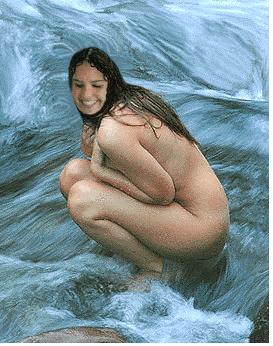...Best of Sicily presents... Best of Sicily Magazine. ... Dedicated to Sicilian art, culture, history, people, places and all things Sicilian. |
by Ignazio Lo Verde | ||
Magazine Index Best of Sicily Arts & Culture Fashion Food & Wine History & Society About Us Travel Faqs Contact Map of Sicily |
Nymphs were beautiful young maidens --nubile yet adult-- found in the company of gods and goddesses. Artemis, Dionysos, Pan and Hermes all had retinues of nymphs. Satyrs lusted after nymphs, usually dryads, who were woodland nymphs. The oceanids were sea nymphs. The oreads were mountain nymphs. The hamadryads were woodland nymphs associated with particular trees, who died when their beloved trees died. Nymphs were linked not only to particular kinds of environments but to certain places as well. They were divinities who lived far longer than ordinary mortals, and always in a state of beauty and youth. Unlike other female creatures (such as the sirens and mermaids), they were explicitly human in form but, unlike the amazons, they were not actually human. Nevertheless, in their vulnerability and other ways the nymphs represented the perceived characteristics of the women of antiquity. In art, they filled a void in the classical Greek world, where mortal (non-divine) male youth was often idealised while females, except for goddesses, were rarely depicted at all. In modern Greek folklore, the nymph takes the form of the nereid, who is not always benevolent. Mythology sought to explain not only human life but the wider world of nature. In the ancient Greek world the nymph represented a particular aspect of nature. Arethusa, like Kyane a naiad, is associated with a spring and pool in Syracuse (Siracusa); Kyane is said to dwell in a river bearing her name in southeastern Sicily. Nymphs were, of course, highly idealised figures, models whose beauty and grace were far beyond the reach of ordinary women. In ancient art they are usually depicted nude and, owing to their youth, shapely but rather slender. The nymphs represented more than mere beauty or a link to nature. They were, in a sense, a manisfestation of life itself. The Romans, as in so many other things imitative of the Greeks, imported the figure of the nymph into their religion and culture. Although the overt sexual nature of the "innocent" nymph doubtless existed in the Greek mind in some form, the Romans developed it further. From the nymph comes the Romans' nymphaeum, a grotto or shrine dedicated to a nymph. Nymphs have left their mark on popular culture. A nymphet is an exceptionally attractive young woman. Nympholepsy is the crazed desire for that which cannot be obtained. Nymphomania is a woman's uncontrollable sexual desire, and if the condition is chronic she is a nymphomaniac. Kyane attempted --but failed-- to prevent Hades from abducting Persephone, and the evil god of the underworld turned her into water. There are several versions of this myth; in a popular one Kyane melted into water out of tearful despair for her friend, Persephone. Therefore, the nymph literally became a pool of tears. Demeter (or Kore), the mother of Persephone, sought to ask Kyane of her daughter's fate. As Kyane, now a spring, could not speak, she allowed Persephone's belt to wash up at Demerter's feet as a sign. The Ciane River, known for its papyrus, seems to have been associated with the water nymph from an early date, the Greeks having settled eastern Sicily before 700 BC (BCE). Kyane was venerated at a site overlooking this river (where she was said to dwell), into which Heracles (Hercules) is said to have tossed a bull as a sacrifice to her. In ancient Greek times Sicily was much greener than today when, except for Etna, the Nebrodi and the Madonie mountains, there are few forests and streams on the island. There were vast coniferous forests, native (but now long-extinct) deer, plenty of wild cats and birds such as the purple swamp hen. In ancient times Sicily had navigable rivers and Kyane's was just one of them. But her myth, and the ideal of youthful beauty lasting for a very long time, endures. Perhaps there's a touch of nympholepsy in each of us.
About the Author: Ignazio Lo Verde lectures on Greek classics and other subjects. | |
Top of Page |
 In the eternal realm of Greek mythology, Kyane, or Cyane
(Italian Ciane) was a nymph or, more precisely, a naiad. The
naiads were freshwater nymphs. Appropriately, the Classical Greek kyanos
meant "blue-green" (hence the English cyan) and alludes
to the water of lakes and streams. But what is a nymph?
In the eternal realm of Greek mythology, Kyane, or Cyane
(Italian Ciane) was a nymph or, more precisely, a naiad. The
naiads were freshwater nymphs. Appropriately, the Classical Greek kyanos
meant "blue-green" (hence the English cyan) and alludes
to the water of lakes and streams. But what is a nymph?